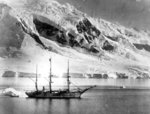HURLEYVILLE, NY — Dr. Frederick Cook was credited with saving lives and deeply caring about the Indigenous people he met. He also explored the Earth’s poles and documented his travels …
Stay informed about your community and support local independent journalism.
Subscribe to The River Reporter today. click here
This item is available in full to subscribers.
Please log in to continue |


HURLEYVILLE, NY — Dr. Frederick Cook was credited with saving lives and deeply caring about the Indigenous people he met. He also explored the Earth’s poles and documented his travels with the photographs he took.
The Frederick Cook Society has dedicated itself to learning more about him. And now a new exhibit of photographs taken by Cook, along with items which highlight his life, will be on display at the Sullivan County Museum.
The exhibition opens on Friday, June 10, and a reception will be held from 5 p.m. to 7 p.m.
Cook was an Arctic and Antarctic explorer, a writer, ethnographer, physician and photographer. He was born in Hortonville, NY.
The Frederick Cook Society’s exhibit includes images from both the South and North Poles, and part of it comes to the county courtesy of the Ohio State University Byrd Polar Center and the Library of Congress. Also included will be a collection of photographs taken by Cook in Alaska between 1903 and 1908. These images of glaciers, icebergs, lakes, Inuit and animals have been printed from a box of vintage negatives found in the Sullivan County museum’s basement.
The reception will be followed by a brief talk by author Julian Sancton. His recently published book, “Madhouse at the End of the Earth,” tells the story of Cook’s 1897 journey into Antarctica aboard the Belgian exploration ship Belgica. During that voyage, which was led by Belgian Royal Navy officer Adrian de Gerlache, the ship spent 13 months trapped in pack ice.
In an 1898 diary entry, Cook described the situation. “We are imprisoned in an endless sea of ice... We have told all the tales, real and imaginative, to which we are equal. Time weighs heavily upon us as the darkness slowly advances.”
The Belgica’s 19-member crew struggled with boredom, scurvy and madness. Cook is often credited with saving their lives. He implemented dietary changes, light therapy, exercise, and a visionary plan to cut channels through the ice and free the ship. The men who survived became the first group of explorers to overwinter in Antarctica.
Cook was also widely known for his good nature, the Cook Society said, and this quality endeared him to the Inuit people. He learned the Inuit language and used his medical training to care for their sick. When he returned to New York, he had a collection of Inuit artifacts, including bone carvings, hunting tools, soapstone talismans, sealskins and beaded items. A selection of these pieces will be included in the exhibition.
The Frederick Cook Society is a worldwide organization of people interested in the life and work of Dr. Cook. The society has a gallery and a research library in the Sullivan County Cultural Center and Museum, located at 265 Main St.. To learn more, visit www.frederickcookpolar.org or find the society on Facebook at Friends of Frederick Cook. You can also call the Cook Society at 845/434-8044.
Comments
No comments on this item Please log in to comment by clicking here